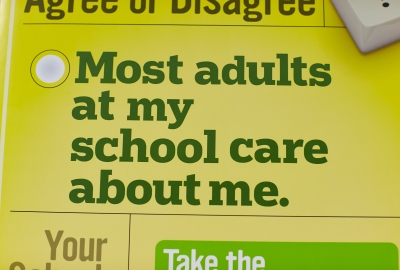
We're Not All Average: Reconceptualizing School Climate to Acknowledge Diverse Student Experiences In Schools
Lisa Merrill, Kristin Black, Reggie Gilliard (December 2021)
How students feel about their schools—their perception of the safety, inclusiveness, rigor, and collaboration in the learning environment—is an increasingly important part of conversations about school quality and improvement. A wide variety of research suggests that positive school climates support students’ academic engagement, growth, and success and make schools more joyful and functional places to work.
For these reasons, measures of school climate have become central to school accountability systems across the country. These measures typically rely on student, teacher, and parent survey responses, which are then aggregated and averaged to characterize the climate of the school as a whole. But what are we missing when we focus on the “average” student experience? How do students’ perceptions of school climate vary? And could a clearer picture of this variation inform efforts to develop more inclusive and equitable learning environments, within schools and across the system?
Building on the Research Alliance’s longstanding work with the NYC Department of Education on its annual School Survey, this report uses survey data from 2015 through 2019 to begin to answer these questions. We start by examining the extent to which students within the same school have similar perceptions of the school’s climate. This part of the analysis focuses on the variation among individual students’ responses to questions about different dimensions of school climate (e.g., trust between students and teachers, peer support, safety, cultural awareness, classroom behavior, academic rigor and support, etc.). To further illustrate this variation, we then zero in on the Student-Teacher Trust measure, exploring how students’ perceptions differ by race/ethnicity, gender, and grade level—looking at differences system-wide and within individual schools.
Drawing on survey responses from more than 70,000 students across 628 middle and high schools, we found:
- School climate measures are more reflective of students' individual experiences than they are of consistent organizational characteristics. Across all measures of school climate, we found much more consistency in how individual students perceived the climate over time than in how students within the same school perceived the climate. These findings suggest that while school climate scores do tell us something about schools as organizations (especially in cases where the average scores are very low or very high, compared to other schools), they probably tell us more about students’ individual experiences.
- Ratings of Student-Teacher Trust were generally high, but there was a lot of variation in students’ responses. The Student-Teacher Trust measure includes items such as “There is at least one adult in the school that I can confide in,” and “My teachers treat me with respect.” On a scale of 1-4 (strongly disagree to strongly agree), responses to these questions mostly clustered between 2.5 and 3.5, with average scores close to 3. However, we also found that individual perceptions of Student-Teacher Trust varied substantially, with extremely high ratings, as well as extremely low ratings, across all schools and all the student subgroups that we looked at.
- Within schools, there were notable differences in perceptions of Student-Teacher Trust associated with race/ethnicity, gender, and grade level. Black students’ perceptions of Student-Teacher Trust were consistently lower—even within the same school—than students from other racial/ethnic backgrounds. Gender differences were relatively small and more pronounced in middle schools than in high schools, with young men rating Student-Teacher Trust slightly lower than young women. We also found some intriguing differences by grade level, with students in 6th and 9th grade reporting higher levels of trust than students in later grades.
Taken together, our findings suggest the need to pay more attention to the various ways in which students experience their school climate, including a better understanding of racial inequities, both within and across schools. Responding to this need, the NYC DOE has begun sharing disaggregated data, allowing stakeholders to see how different subgroups (e.g., young men and women, students of different racial/ethnic groups, English learners, students with disabilities) perceive the learning environment in individual schools. This is a promising and important first step in understanding how to better serve all students.
Looking ahead, researchers should continue working toward a clearer and more nuanced grasp of the factors that shape students’ perceptions of school climate. There is also a need for more evidence about strategies that effectively enhance students’ experiences and engagement in school. We hope to contribute in both areas.

